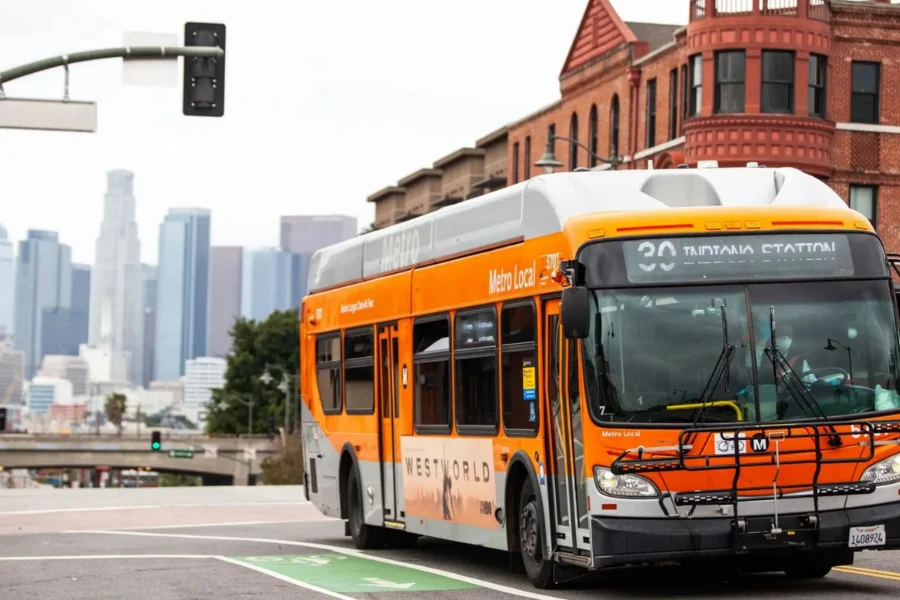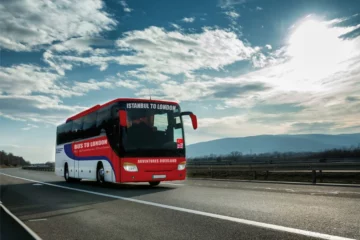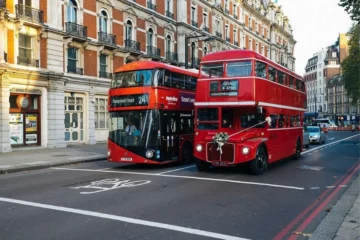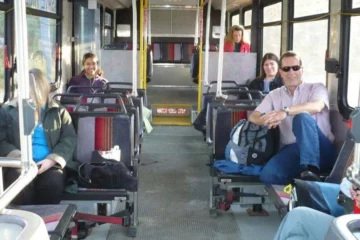The Future of Buses: How Technology is Revolutionizing Public Transportation

Public Transportation | bebevy
The future of public transportation is rapidly changing, with technology leading the way towards more efficient and sustainable modes of travel. Buses, once seen as outdated and inconvenient, are now experiencing a revolution thanks to innovative advancements in technology. From electric and hybrid models to smart bus systems that are designed to optimize routes and reduce traffic, the future of buses is looking bright. As cities around the world continue to grow and become more congested, it’s becoming increasingly important to find new ways to move people around quickly and safely. This is where the future of buses comes in, as they offer a cost-effective and eco-friendly solution that can help to reduce traffic, improve air quality, and make public transportation more accessible to everyone. So buckle up and get ready to explore how technology is revolutionizing the future of buses, and what it means for the future of public transportation as a whole.
Advancements in bus technology
The bus industry has come a long way since the first horse-drawn bus appeared on the streets of Paris in the early 19th century. Today, buses are equipped with some of the most advanced technology available, making them more efficient, cost-effective, and eco-friendly than ever before. One of the most significant advancements in bus technology is the development of electric and hybrid buses. These buses use electricity as their primary power source, which means they produce zero emissions and are much quieter than traditional diesel-powered buses.
Another major advancement is the development of smart bus systems. These systems use real-time data to optimize bus routes, reduce traffic congestion, and improve the overall efficiency of public transportation. They also allow passengers to track the location of their bus in real-time, which means they can plan their journey more effectively and reduce waiting times. Additionally, smart ticketing and payment systems have made it easier for passengers to pay for their journey and reduce the need for physical tickets, which can be lost or stolen.
Benefits of technology in public transportation
The benefits of technology in public transportation are numerous and far-reaching. One of the most significant benefits is the reduction of traffic congestion and associated air pollution. By optimizing bus routes and reducing waiting times, smart bus systems can encourage more people to use public transportation, which means fewer cars on the road and less air pollution. Additionally, electric and hybrid buses produce zero emissions, which means they can help to improve air quality in cities and reduce the carbon footprint of public transportation.
Another benefit of technology in public transportation is improved accessibility. Smart ticketing and payment systems make it easier for passengers to pay for their journey and reduce the need for physical tickets, which can be lost or stolen. Real-time passenger information and tracking also make it easier for passengers to plan their journey and reduce waiting times. This can be particularly beneficial for people with disabilities or those who require extra assistance when traveling.
Smart ticketing and payment systems
Smart ticketing and payment systems are becoming increasingly popular in the public transportation industry. These systems use contactless payment technology, such as NFC or RFID, to allow passengers to pay for their journey using a smartphone, smart card, or other electronic device. This eliminates the need for physical tickets, which can be lost or stolen, and reduces the time and effort required to purchase a ticket.
Smart ticketing and payment systems also offer a range of other benefits. They can be used to offer discounts and promotions to passengers, track passenger data to improve services, and provide real-time information about bus schedules and routes. Additionally, they can help to reduce fraud and revenue leakage by providing a secure and traceable payment system.
Real-time passenger information and tracking
Real-time passenger information and tracking is another important advancement in bus technology. This technology allows passengers to track the location of their bus in real-time using a smartphone app or other electronic device. This means they can plan their journey more effectively and reduce waiting times, which can be particularly beneficial for people with disabilities or those who require extra assistance when traveling.
Real-time passenger information and tracking can also be used to optimize bus routes and reduce traffic congestion. By collecting data about passenger travel patterns and bus usage, smart bus systems can adjust their routes and schedules to better meet the needs of passengers and reduce congestion on the roads.
Electric and hybrid buses
Electric and hybrid buses are becoming increasingly popular in the public transportation industry. These buses use electricity as their primary power source, which means they produce zero emissions and are much quieter than traditional diesel-powered buses. Additionally, they are more fuel-efficient and cost-effective than diesel-powered buses, which means they can save money for public transportation providers in the long run.
Electric and hybrid buses also offer a range of other benefits. They can help to improve air quality in cities, reduce the carbon footprint of public transportation, and provide a more comfortable and enjoyable ride for passengers. Additionally, they can be used as a marketing tool to promote the eco-friendliness of public transportation services and encourage more people to use them.
Autonomous buses
Autonomous buses, also known as self-driving buses, are another important advancement in bus technology. These buses use sensors and other advanced technology to navigate roads and transport passengers without the need for a human driver. This means they can operate 24/7, reduce the risk of accidents caused by human error, and provide a more efficient and cost-effective transportation solution.
However, there are also some potential challenges and obstacles associated with autonomous buses. For example, there may be concerns about the safety and reliability of these buses, as well as the potential impact on employment in the public transportation industry. Additionally, there may be regulatory and legal issues that need to be addressed before these buses can be widely adopted.
Integration with other modes of transportation
One of the key challenges facing the public transportation industry is how to integrate different modes of transportation, such as buses, trains, and bicycles, into a seamless and efficient network. Fortunately, technology is also playing a role in solving this challenge. For example, smart bus systems can be integrated with other modes of transportation to provide a more comprehensive and efficient transportation solution.
Additionally, electric and hybrid buses can be used in conjunction with other eco-friendly transportation options, such as bicycles and electric scooters, to provide a more sustainable and eco-friendly transportation network. This can help to reduce traffic congestion, improve air quality, and make public transportation more accessible and convenient for a wider range of people.
Challenges and potential obstacles
Despite the many benefits of technology in the public transportation industry, there are also some potential challenges and obstacles that need to be addressed. One of the biggest challenges is the cost of implementing these technologies. Electric and hybrid buses, for example, can be more expensive than traditional diesel-powered buses, which means they may not be affordable for all public transportation providers.
Additionally, there may be regulatory and legal issues that need to be addressed before some technologies can be widely adopted. For example, autonomous buses may require new regulations and safety standards to ensure they can operate safely and reliably on public roads.
Future predictions for the bus industry
The future of the bus industry is looking bright, thanks to the many innovative advancements in technology that are being developed. Electric and hybrid buses, smart bus systems, and autonomous buses are just a few of the many technologies that are set to transform the public transportation industry in the coming years. By providing a more efficient, cost-effective, and eco-friendly transportation solution, these technologies can help to make public transportation more accessible and convenient for everyone.
Conclusion
The future of buses is looking bright, thanks to the many innovative advancements in technology that are being developed. Electric and hybrid buses, smart bus systems, and autonomous buses are just a few of the many technologies that are set to transform the public transportation industry in the coming years. By providing a more efficient, cost-effective, and eco-friendly transportation solution, these technologies can help to reduce traffic congestion, improve air quality, and make public transportation more accessible and convenient for everyone. So buckle up and get ready for the future of buses!







